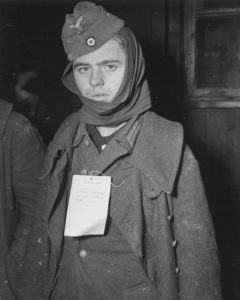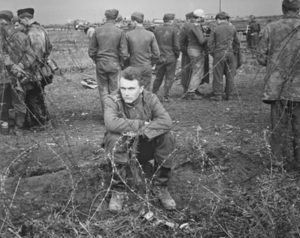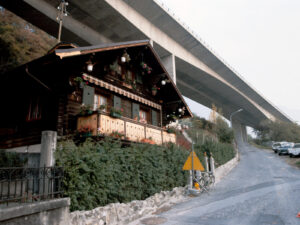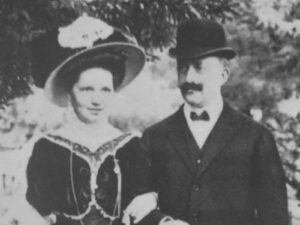
Wikimedia / U.S. National Archives
German prisoners of war in Switzerland
After World War II, many German soldiers escaped to, and through, Switzerland. Swiss authorities responded in different ways: some of these fugitives were deported, while others were interned.
Between 1945 and 1947 1,065,000 German prisoners of war were held in France. 740,000 of them came from American internment camps, and 237,000 had been captured on French territory. The rest came from North Africa, where they had been in British custody. After being sent to war-ravaged France to help with reconstruction, many – almost 40,000 – lost their lives on minefields or died in captivity.
As in scores of other countries, in France the war left further casualties in its wake after it ended. The French were keen to settle old scores, and showed little mercy towards their erstwhile tormentors. Hunger, appalling sanitary conditions, prisoners sleeping in holes in the ground: ICRC inspection reports went so far as to compare the French camps with Buchenwald or Dachau. In condemning the conditions, the main aim was to get a response out of the French authorities, which at the time were understandably very hostile to Germany.
ESCAPE TO SWITZERLAND
During their captivity, which lasted for months, more than 80,000 men – mostly members of the Wehrmacht – managed to escape from the French camps. They wanted to go home. It is the irony of fate that some – like countless Jews just a few months before – sought safety in Switzerland. They travelled by night, on unsafe roads, or as unseeing passengers in windowless railway goods wagons. Some managed to reach the Swiss border and catch the right moment to cross.

French internment camp with 10,000 German soldiers.
Wikimedia / U.S. National Archives
The exodus began in April 1945, when French forces entered Konstanz. German civilians and soldiers panicked, and a throng gathered at the Swiss border. On 26 April, 150 members of the Wehrmacht and German customs officials appeared at the border and asked for permission to enter Switzerland, where they were subsequently interned. Soon after that, in May 1945, 400 Russians in the service of the Germans – known as ‘Vlassov’s Cossacks’ – arrived in Liechtenstein, some of them accompanied by women and children, and asked the Swiss customs officers to intern them. However, they were ‘undesirable’ and were turned away. That was just the beginning. They were soon followed by fleeing prisoners of war.
In August 1945, police stationed in Fleurier near Lake Neuchâtel picked up two German prisoners of war who had escaped from the Valdahon dans le Doubs camp, and rounded up three more fugitives in Boudry several days later. Three Germans were caught in Corcelles and deported to France by military force. And in October 1945, four Wehrmacht soldiers who had escaped from a camp in Annemasse and were trying to return to their homeland were picked up in Vullierens (Canton of Vaud). Fugitives also turned up in Geneva. It was employees of the Swiss Federal Railways (SBB) who, in January 1946, discovered two escapees from a camp in Toulon in a rail car at Cornavin station. Two more German soldiers were apprehended in Bellevue and handed over to the French authorities in August. In summer 1946, a significant increase in German fugitives was observed in Switzerland.
With the Wehrmacht officially dissolved in Berlin on 20 August 1946, the Vaud Gendarmerie in Marchissy detained four German soldiers in civilian and military clothing who had escaped from a prison camp in Annecy. Four others who were on their way back to Germany from Naples were caught in a forest near Courrendlin in the Jura. The following month, five German fugitives were apprehended in Bern and handed over. At the same time, the trial of Otto Löliger took place in Lucerne. The former first lieutenant in the Swiss Armed Forces had joined the Waffen-SS in 1942, and had achieved the rank of Oberstumführer, a senior commander. His sentence, seven years in prison, sparked a huge media response.

German prisoners of war.
Wikimedia / U.S. National Archives
THEFTS AND BREAK-INS
At that time, Swiss newspapers often reported on the war crimes of the Nazis, the deplorable conditions in the concentration camps and the situation in Germany under Allied occupation, because the numerous attempts by German prisoners of war to cross the country attracted the attention of journalists and the federal administration alike. The authorities published relevant figures in April 1947. In 1946, 99 deportation orders were handed out against escaped German prisoners of war. The reason for this was criminal offences. Penniless and often completely alone, these fugitives didn’t shy away from engaging in a little light theft and burglary when the opportunity arose:
‘Scarcely a week goes by in which these people do not commit a crime as soon as they set foot in Vaud.’
The Gazette de Lausanne noted that
‘the borders are standing half open, and the evildoers of the world are slipping back in in greater numbers. Working with the police forces abroad, the Service de la sécurité publique of the Canton of Vaud has received effective assistance, culminating in the successful apprehension of a number of malfeasants.’
The close contact with the French police was marked by amicable cooperation.
‘In the past year, around 100 escaped German prisoners of war have crossed our border and entered Vaud territory. In order to prevent their presence from leading to an increase in offences, the commander of the cantonal police force has ordered increased surveillance; 24 escaped German prisoners of war were convicted of committing criminal offences, detained and brought to justice; they had committed numerous thefts, mainly of bicycles.’
In spring 1947, another 347 escaped prisoners of war made the list.
Although all German prisoners were gradually released from France from April 1947 onwards, the migration movements continued throughout the year. In the spring, Luftwaffe pilots who had managed to get away from their American captors in France were apprehended, detained and promptly returned to the French gendarmerie. Between February and September, a total of 398 German prisoners of war who had escaped from France were captured on Vaud soil. 42 of them – former SS members – were sent back immediately. It wasn’t until 1948 that the numbers started to fall.
TAKE IN OR DEPORT?
In the first few years after the war, several hundred Germans attempting to make their way home were caught on Swiss soil. However, as is clear from the Bergier Report, the case of the escaped prisoners of war was especially problematic, because according to the Hague Convention they could be taken in by a neutral state. However, there was no obligation to do so. Switzerland thus had a certain degree of leeway in its decision-making. While French soldiers who had fled German camps were allowed, until 1942, to cross Switzerland to reach unoccupied France, the Department of Justice and Police called for the utmost restraint and asked that people stay away from ‘undesirable elements’, which often had dramatic consequences, depending on the origin of those concerned.

View of a prison camp downriver from Rome.
Wikimedia / U.S. National Archives
Former soldiers of the Wehrmacht were treated quite roughly, but at least less cruelly than those previously refused entry. Some, like the Red Army soldiers who escaped from the Nazi camps and sought refuge in Switzerland, were placed in camps run by the Federal Commissariat for Internment and Hospitalisation (Kommissariat für Internierung und Hospitalisierung), founded by the Military Department in June 1940. Others were handed over to the foreign authorities.
The situation eased after the end of the war, but the Federal Council still passed a resolution in 1947 to relax refugee and emigrant policy. This resolution entered into force on 20 March, and was limited to three years. After that, only people born before 1889, the sick, the frail and infirm, children under 16 and orphans were allowed to stay in Switzerland. However, exceptions were often allowed. Permission to stay was given, among other things, to people who were able to demonstrate ‘special skills and merits, particularly in the scientific, intellectual, artistic, social, humanitarian or economic fields’. In the end, the confederate immigration authorities decided on the applications and the fate of the escaped Germans.
ESCAPE AID FOR THE GERMANS
While some of the fugitives were caught, others managed to reach Germany. One can only speculate on the numbers of those who were successful. It is known, however, that some of them received help. Until the closure of the German diplomatic missions in Bern on 8 May 1945, these fugitives were able to count on the unofficial help of the German consulates, to which some of them may have turned. Help was also provided by the German section of the Red Cross Central Prisoners of War Agency in Geneva, and by Werner von Holleben. The German consul in Geneva remained in Switzerland until 1946, even though the federal government officially deported the staff of the German missions to Germany. It was thanks to his role as secretary of the Young Men’s Christian Association that von Holleben was able to stay.
It seems obvious that the German section of the Central Prisoners of War Agency and certainly also the Young Men’s Christian Association would be involved in the repatriation of the German refugees through Switzerland, but the logistical support required a whole network. This help came from people who provided humanitarian aid and offered discreet lodging, food and support. These people included, among others, nurse Barbara Borsinger and Viola Riederer von Paar zu Schönau, a doctor, who hid a certain number of German fugitives in the basement of the Grangettes Clinic, as well as Swiss-German Jesuits, who provided these escaped prisoners with new clothes and helped them cross the border in Basel. It was a philanthropic operation which called for secrecy because of the administrative measures to which the prisoners of war were subject, and which no doubt would not have been understood by most of the population. It was led – in the case of Barbara Borsinger and Viola Riederer – by women who felt compelled by a profound faith and who had already helped scores of Jewish children during World War II.

Barbara Borsinger.
Archives Hôpitaux Universitaires de Genève



